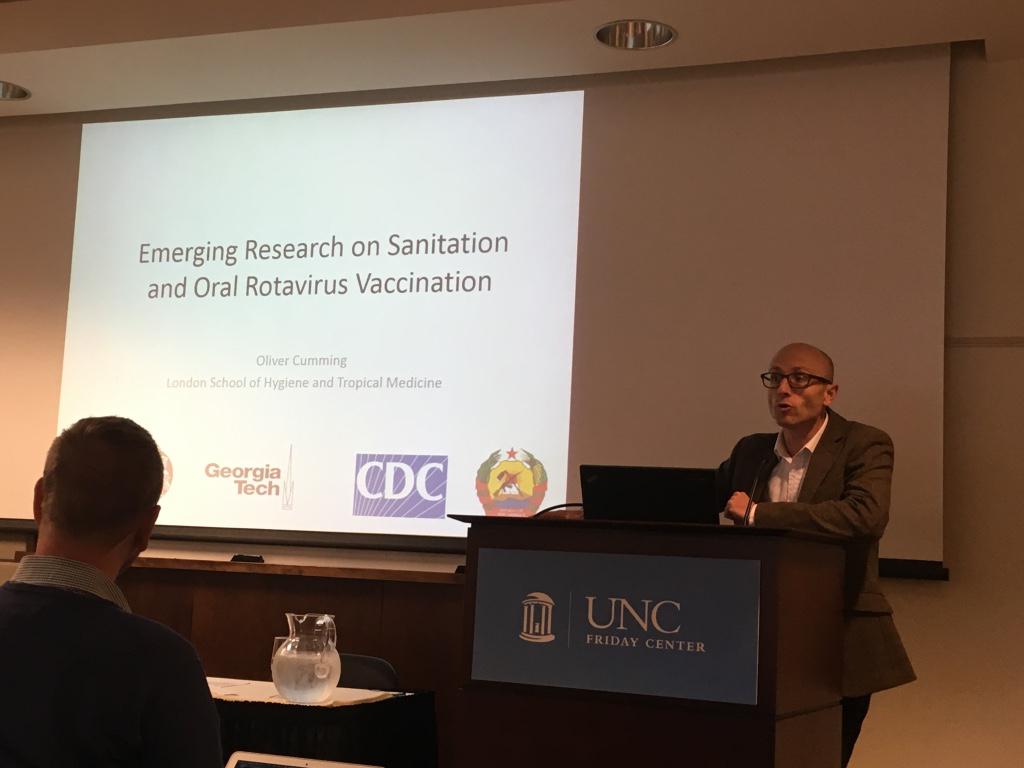SHARE at UNC Water and Health Conference

The Water and Health Conference at the University of North Carolina, Chapel Hill took place from 10-14th October 2016. SHARE funded two sessions at the event – one on evidence for action on WASH in health care facilities, and another on WASH and Vaccines. Lauren D’Mello-Guyett from the London School of Hygiene and Tropical Medicine reports back on her time there.
In collaboration with the World Health Organization (WHO), UNC Water Institute and UNICEF, SHARE convened an engaging session at the Water and Health Conference which touched on many aspects of WASH in HCFs, from monitoring to engaging policymakers.
This is a vitally important topic as many aspects of WASH are essential to the functioning of any HCF. These include adequate quantity and quality of drinking water, safe management of excreta and healthcare waste, as well as hygienic practices like handwashing and environmental cleansing.
Session kicks off
The event started with an introduction by Fabrice Fotso, WASH Specialist at UNICEF, who gave us an insightful update on the global action, linking WASH and HCFs to the SDGs. He spoke of the need to continue to elevate and embed the issue of WASH in HCFs within health systems, health programmes and policies, as well as strengthen monitoring and accountability and empower leaders at every level. Drawing our attention to the WASH in HCF Knowledge portal, he encouraged people to get involved and contribute to it.
Monitoring WASH in HCFs
The next talk by Rick Johnson of the Joint Monitoring Programme (JMP) at WHO focussed on strengthening the monitoring of WASH in HCF. Monitoring plays an important role for WASH in HCF, particularly in relation to the SGDs. He spoke about how the WHO/UNICEF JMP have developed a set of WASH in HCF core indicators for SDGs, which are publicly available on the JMP website as well as in the WASH in HCF knowledge portal.
Snapshot of evidence
Following that, Ryan Cronk from the University of North Carolina gave us an overview of environmental conditions and standard precautions in HCFs. He provided an update on the 2015 WHO/UNICEF report on WASH in HCF. This new review will be larger, including 76 LMICs, representing 128,000 facilities (double that of the 2015 review). He also noted the importance of defining the types of health care facilities and standard reporting approaches. This can improve the comparability of data, as well as show examples of how monitoring data is used to advocate and influence change at the country and facility level.
Case study: Tanzania
Dr Hamisi Malebo from the Tanzanian Ministry of Health helped to illustrate some of the points mentioned with an example of strengthening monitoring of WASH in Tanzanian Maternal and Child Health units. He provided an overview of the research, which was conducted in seven districts, where 96 HCFs were surveyed (21% of the total). In all seven districts, E. coli contamination was reported, and surface cleanliness was a key challenge. Additionally, in 2014, less than 1% of the Department of Health’s budget was allocated for WASH in HCFs. The study recommended that joint sectors should undergo policy and planning reforms, and national efforts to reduce maternal and newborn mortality and morbidity should adequately reflect on WASH improvements as a prerequisite for ensuring the quality, effectiveness and use of health care services.
Health impacts of poor WASH in HCFs
Oliver Cumming from LSHTM presented the rational and methodology for a systematic review, arguing that WASH in HCFs could affect the global burden of disease. He highlighted the summary results of a rapid review of WASH in LMICs health care associated infections (HCAI) studies, as well as a rapid review of HCAI in WASH studies. The next steps include Cochrane Public Health Group ongoing application review and contacting expert researchers and organisations wanting to be involved.
Nuts and bolts of developing a burden of disease framework
Using the example of WASH and diarrhoea, Anne Pruss-Ushtan from WHO presented a summary of the burden of disease analysis methodology. She noted that a burden of disease analysis would be useful for cost effectiveness analyses, raising awareness of issues and policymaking for programme implementation.
Relevance to policymakers and practitioners
The next part consisted of three minute presentations by Paul Hunter (University of East Anglia), Jordan Smoke (World Vision), Rob Quick (CDC) and Hamisi Malebo (MoH Tanzania). They highlighted the need to understand how WASH affects the experience of care, as well as how sustainability of WASH infrastructures and practices can be addressed in the health care setting. The session ended with a reminder of the importance of dissemination (such as case studies) to stimulate action at all levels of the health system to change policy and practice.
Reflections
The session gave the audience food for thought, highlighting the importance of WASH in HCFs and its impact on policy and practice. It was also a great opportunity to engage the audience on the systematic review process being conducted by SHARE and update the sector on the WASH in HCF Global Action Plan. Several key questions and tasks for future research came about, including exploring behaviours around WASH in HCFs and how this affects performance, satisfactions and care-seeking attitudes.
